Discover Florida Nature
It's time to explore the natural Florida


|
|
|
|
|
Slimy Salamander- Slimy Salamanders forage at night and then
burrow during the day under leaf litter, rotten logs, and stones. Eggs
are usually laid under logs. In coastal region, eggs are laid annually
in late summer and fall. The slimy salamander has an extensive range
throughout the eastern and central United States. Starting in central
New York and the southern tip of Wisconsin, the range covers much of the
eastern seaboard, moving southward to central Florida and the Gulf coast
and westward to parts of east Texas and Oklahoma. The slimy salamander
has mainly black skin, covered by abundant silver-white or brassy
specks, or both; the ventrum has variable shades but is generally
lighter than the dorsum. The organism is distinguished from other dark
salamanders in its range by the presence of a nasolabial groove.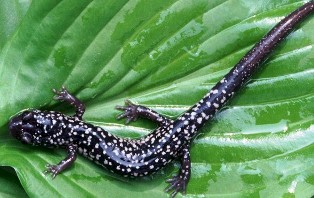 Marbled
Salamander- Adult marbled salamanders live in damp woodlands,
often close to ponds or streams. These salamanders are occasionally can
be found around dry hillsides, but never far from a moist environment.
The marbled salamander ranges in size from about 3 to 5 inches in total
length. The ground color is black, and there are numerous silver-white
crossbands, giving the marbled appearance for which the species is
named. There is considerable variation in the crossbanding pattern, as
in some individuals they are extensively connected, and in others the
connection is minimal. The nesting female typically curls herself
around the eggs while waiting for rain to fill nest cavity. The larvae
usually hatch a few days after inundation. If autumn rains are scant,
eggs may not hatch until spring. Marbled
Salamander- Adult marbled salamanders live in damp woodlands,
often close to ponds or streams. These salamanders are occasionally can
be found around dry hillsides, but never far from a moist environment.
The marbled salamander ranges in size from about 3 to 5 inches in total
length. The ground color is black, and there are numerous silver-white
crossbands, giving the marbled appearance for which the species is
named. There is considerable variation in the crossbanding pattern, as
in some individuals they are extensively connected, and in others the
connection is minimal. The nesting female typically curls herself
around the eggs while waiting for rain to fill nest cavity. The larvae
usually hatch a few days after inundation. If autumn rains are scant,
eggs may not hatch until spring.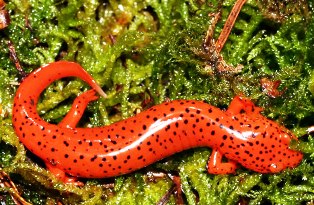 Red
Salamander- The Red Salamander can be found in terrestrial or
aquatic environments, but are aquatic in winter. In the terrestrial
environment they can typically be found in wooded areas under fallen
bark, logs, and rocks. Their aquatic preference is in the leaf litter of
clean running, cool streams and brooks. The red salamander is a
stout-bodied, medium-sized salamander ranging between four and seven
inches (10 to 18 cm) in length. There are a few major field marks that
can be used to identify this salamander. The dorsum and sides of this
salamander vary from a purplish brown to a bright crimson red. Younger
specimens are brighter in color, while adults tend to darken with age. Red
Salamander- The Red Salamander can be found in terrestrial or
aquatic environments, but are aquatic in winter. In the terrestrial
environment they can typically be found in wooded areas under fallen
bark, logs, and rocks. Their aquatic preference is in the leaf litter of
clean running, cool streams and brooks. The red salamander is a
stout-bodied, medium-sized salamander ranging between four and seven
inches (10 to 18 cm) in length. There are a few major field marks that
can be used to identify this salamander. The dorsum and sides of this
salamander vary from a purplish brown to a bright crimson red. Younger
specimens are brighter in color, while adults tend to darken with age.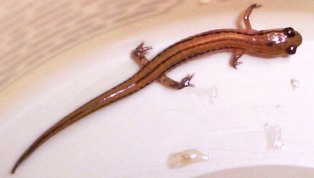 Dwarf
Salamander- The dwarf salamander is aptly named, as it is one
of the smallest vertebrates in North America. Full-grown adults
frequently weigh less than one gram and may be less than 2 inches long
from snout to tail tip. Superficially, the dwarf salamander may look
like a tiny southern two-lined salamander, but there is one sure
character for diagnosis: The dwarf salamander has only four toes on each
of its back feet. Usually found under leaf litter, logs and stones in
wet forests, swamps, and pine savanna ponds, the dwarf salamander is
bronze with dark brown or black stripes running down the back. The belly
is bright yellow. Dwarf
Salamander- The dwarf salamander is aptly named, as it is one
of the smallest vertebrates in North America. Full-grown adults
frequently weigh less than one gram and may be less than 2 inches long
from snout to tail tip. Superficially, the dwarf salamander may look
like a tiny southern two-lined salamander, but there is one sure
character for diagnosis: The dwarf salamander has only four toes on each
of its back feet. Usually found under leaf litter, logs and stones in
wet forests, swamps, and pine savanna ponds, the dwarf salamander is
bronze with dark brown or black stripes running down the back. The belly
is bright yellow.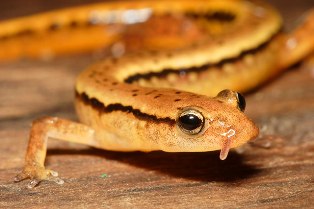 Southern
two-lined Salamander- The Southern Two-lined Salamander is very
similar in appearance to the Northern Two-lined Salamander. They are
small and slender with a broad yellow, greenish-yellow, or tan stripe
that extends from head to tail. The light dorsal stripe is bordered by
uneven black lines and is often marked with a row of dark spots or
flecks. The sides of the body are usually yellowish with some dark
mottling, and the belly is typically yellow. The best way to distinguish
between the Southern and Northern Two-lined Salamander is by geographic
range. Southern Two-lined Salamanders are distributed from southern West
Virginia to eastern Illinois and south into northern Florida and east
Louisiana. Living close to flowing water, both in woodland and open
areas, the Two-Lined Salamander can be found under rocks, logs, or leaf
mats. During winter months individuals seek shelter and retreat
underground. Southern
two-lined Salamander- The Southern Two-lined Salamander is very
similar in appearance to the Northern Two-lined Salamander. They are
small and slender with a broad yellow, greenish-yellow, or tan stripe
that extends from head to tail. The light dorsal stripe is bordered by
uneven black lines and is often marked with a row of dark spots or
flecks. The sides of the body are usually yellowish with some dark
mottling, and the belly is typically yellow. The best way to distinguish
between the Southern and Northern Two-lined Salamander is by geographic
range. Southern Two-lined Salamanders are distributed from southern West
Virginia to eastern Illinois and south into northern Florida and east
Louisiana. Living close to flowing water, both in woodland and open
areas, the Two-Lined Salamander can be found under rocks, logs, or leaf
mats. During winter months individuals seek shelter and retreat
underground. 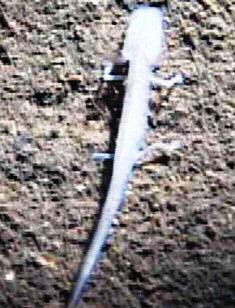 Georgia
Blind Salamander- The Georgia Blind Salamander is found in
clear water in caves where bats are present near the Georgia border. The
Georgia Blind Salamander no eyes or pigment. It has bright red feathery
external gills, long, thin legs, and a finned tail. It reaches a length
of only 3". Its name is due to the fact that the specimen was first
discovered in a 200 foot well in Albany, Georgia. It has since been
discovered in Climax Cave in Decatur County Georgia, but for the most
part they are distributed in 11 cave systems along the Florida Panhandle
around Jackson County. The Georgia blind salamander is the only
vertebrate cave dweller in Floridian caves. Georgia blind salamanders
live a slow-moving life, creeping over the bottom and up along walls of
caves. They are more common close to cave entrances, as food is more
plentiful here. They feed on a variety of cave crayfishes, isopods,
copepods, and detritus. Because of its limited distribution, the Georgia
blind salamander has been seriously threatened by habitat loss. As a
result the species is now protected in both states where they reside. So
few Georgia Blinds have been collected that little is known about them.
Adults retain larval characteristics and are unable to transform to a
terrestrial stage. Georgia
Blind Salamander- The Georgia Blind Salamander is found in
clear water in caves where bats are present near the Georgia border. The
Georgia Blind Salamander no eyes or pigment. It has bright red feathery
external gills, long, thin legs, and a finned tail. It reaches a length
of only 3". Its name is due to the fact that the specimen was first
discovered in a 200 foot well in Albany, Georgia. It has since been
discovered in Climax Cave in Decatur County Georgia, but for the most
part they are distributed in 11 cave systems along the Florida Panhandle
around Jackson County. The Georgia blind salamander is the only
vertebrate cave dweller in Floridian caves. Georgia blind salamanders
live a slow-moving life, creeping over the bottom and up along walls of
caves. They are more common close to cave entrances, as food is more
plentiful here. They feed on a variety of cave crayfishes, isopods,
copepods, and detritus. Because of its limited distribution, the Georgia
blind salamander has been seriously threatened by habitat loss. As a
result the species is now protected in both states where they reside. So
few Georgia Blinds have been collected that little is known about them.
Adults retain larval characteristics and are unable to transform to a
terrestrial stage. |
|
|
Advertise | Privacy Statement | Dog Encyclopedia | Video |Contact | Alaska Nature |
|